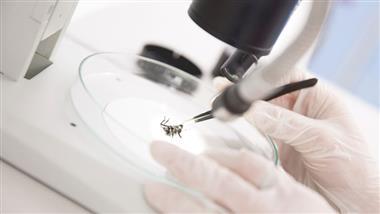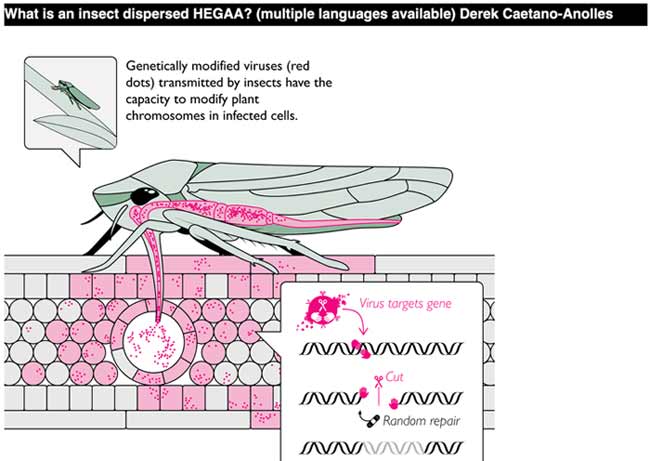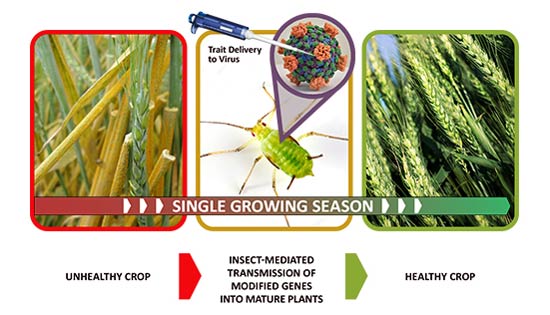DARPA, les insectes, la science devenue folle et nous
DARPA : La Defense Advanced Research Projects Agency est une agence du département de la Défense des États-Unis chargée de la recherche et développement des nouvelles technologies destinées à un usage militaire. Wikipédia
De : https://articles.mercola.com/sites/articles/archive/2022/07/28/darpa-insect-allies.aspx?
Les articles gratuits en anglais de Dr Mercola sont enlevés de son site sous 48 H . Pour en permettre la lecture aux anglophones et anglicistes , ces articles sont proposés par ce blog dans leur forme originale avec traduction automatique possible ici : https://translate.google.com/translate?hl=fr&sl=en&tl=fr&u=https://etouffoir.blogspot.com/2022/07/darpa-les-insectes-la-science-devenue.html
DARPA, Insects, Mad Science, and Us: Nowhere to Hide

Story at-a-glance
- Irresponsible use of new and very advanced technologies by the military is life-threatening
- Engineered viruses can be used to edit genes in a target species, including in a heritable manner
- “Insect Allies” is a DARPA program designed to genetically modify mature plants in a live environment by releasing insects infected with genetically modified viruses
- Some scientists, although on board with genetic modification in principle, are questioning DARPA’s motives and raising concerns
- Researchers in Singapore, as well as DARPA in the U.S. have developed “remote-controlled insects”
BREAKING NEWS: The craziest crazies have somehow escaped the asylum and installed themselves in high positions of power. Insane, they are coming up with one bad idea after another and barking orders at us, mad shine in their eyes and saliva coming out of their mouths. They are crazy — and in charge of institutions, schools, newspapers and armies.
They are running around with their high-tech pistols filled with high-tech poisons and their little sadistic CRISPR scissors. They are crazy — yes, they are crazy — and they are killing us slowly, and sometimes not so slowly. Welcome to the future where toxicity is health and the old crazy is the new normal. We are not crazy — they are crazy — and they have been from the beginning. And in 2020, they stopped pretending. What now?
Project “Insect Allies”
You may think that you have seen it all but here is a great idea. Take some insects, infect them with a genetically modified virus designed to genetically edit mature plants in real time, and release them. Release them into wild and repeat, “it’s safe and effective.”
Sweet idea, right? Well, DARPA thought so, and so in 2016, they started a project called “Insect Allies” that is designed to do that. (This is a different project from Oxitec’s controversial release of GM mosquitos.) DARPA’s official story is that in the name of national security, a good way to protect the American crops from potential threats is to genetically modify them using GM viruses as genetic modifiers and insects as flying syringes. And that they just need to test it!
In a 2016 release titled, “DARPA Enlists Insects to Protect Agricultural Food Supply,” the agency stated:
“A new DARPA program is poised to provide an alternative to traditional agricultural threat response, using targeted gene therapy to protect mature plants within a single growing season.
DARPA proposes to leverage a natural and very efficient two-step delivery system to transfer modified genes to plants: insect vectors and the plant viruses they transmit. In the process, DARPA aims to transform certain insect pests into ‘Insect Allies,’ the name of the new effort.”
“‘Insect Allies’ three technical areas — trait design, insect vector optimization, and selective gene therapy in mature plants — layer together to support the goal of rapidly transforming mature plants to protect against natural or intentional agricultural disruption without the need for extensive infrastructure. The foundational knowledge and generalizable tools developed under the program could also support future agricultural innovation.”
Some suspicious peasants may foolishly wonder: What will happen in the short term and in the long term to the people who eat those plants, to the people and animals possibly bitten by those insects, to the wild insects who mate with the infected insects, and to all other life in the area and beyond that may get impacted? What ridiculous nonsense. Here is the answer, peasant: No one knows — and importantly, no one cares. Any more questions?
The first Insect Allies funded paper, titled, “Multiplexed heritable gene editing using RNA viruses and mobile single guide RNAs,” was published in 2020. Please note the word “heritable” in the headline. The paper stated:
“Mutant progeny are recovered in the next generation at frequencies ranging from 65 to 100%; up to 30% of progeny derived from plants infected with a virus expressing three sgRNAs have mutations in all three targeted loci.”
DARPA never disclosed if they tested this program outside of greenhouses.
Objections From the Scientific Community and Even the Pre-2020 Media
Actually, it turned out that a few scientists care — and at least during the pre-COVID era, they have objected.
Here is a short 2019 educational animation made by the German Max Planck Society (formerly the Max Planck Institute for the Science of Human History). Their main objection is the potential weaponization of the technology, they don’t mind the gene editing in principle.
But our standards for health and dignity are so low that this objection is better than no objection, and even this limited kind of objection and questioning DARPA takes some courage (even though it’s unknown if they would have objected in 2020).
And here is what Vice (!!) had to say in 2018 about the outcry from scientists:
“In the editorial, published on Thursday in Science Magazine, scientists from the Max Planck Institute for Evolutionary Biology and the University of Freiburg in Germany, and France’s Université de Montpellier, requested more transparency and opportunities for public discussion regarding the project and its implications.
‘Easy simplifications could be used to generate a new class of biological weapons,’ a press release reads, ‘weapons that would be extremely transmissible to susceptible crop species due to insect dispersion as the means of delivery.’”
What did DARPA say?
“In an email to Motherboard, a DARPA spokesperson rebutted the thesis of the Science Magazine piece and denied any intent to deploy technology developed through Insect Allies in an offensive setting.
‘We created Insect Allies specifically to develop technology that can deliver positive, protective traits to plants to help them survive unanticipated and/or fast-moving agricultural threats,’ the spokesperson wrote. ‘We see it as a critical addition to the national security toolkit, part of a layered strategy to preserve the security of the food supply.’”
“The Insect Allies program is a collaboration between the Defense Advanced Research Projects Agency (DARPA), Environmental Protection Agency, US Army, and other agencies. According to a DARPA slide presentation, the goal of Insect Allies is to “stably transform multiple mature crop plants in a complex, multi-species plant and insect community with enhanced trait(s) of agricultural interest” by mid-2021.”
Newsweek covered it, too. In a 2018 article, they said that “the U.S. government's Defense Advanced Research Projects Agency (DARPA) has been accused of trying to create a new class of biological weapons that would be delivered via virus-infected insects.”
“Scientists with DARPA are looking at introducing genetically modified viruses that can edit chromosomes directly in fields — these are known as horizontal environmental genetic alteration agents (HEGAAs). The DARPA program is using the principles of HEGAAs but, unlike traditional methods of dispersal — like spraying fields with them — it wants to spread them through insects.”
The researchers raising the alarm asked specifically why, for agricultural use, it was so important to use insects as gene modification vectors, given that spraying was available. In response to Newsweek at the time, DARPA denied all allegations of military use and reiterated that the project’s aim was to protect American crops. In 2022, another paper was published where researchers expressed their concerns:
“The hazard and exposure potential of an HEGAA approach can vary greatly depending on the viruses, vector insects, target plant species, and genetic modifications selected and their effects. However, at the current stage of development, the most critical aspect is the compromised reliability of the HEGAA approach, owing mainly to its complex design with three different species ...
They are a cause for concern because of the numerous effects that can increase the potential for hazard and exposure. Combined with the current inadequacy of corrective measures, it is clear that there is an urgent need for early analysis of whether HEGAA approaches can be inherently contained and controlled by their specific technology design.”
“Horizontal Environmental Genetic Alteration Agents”
What are HEGAAs? According to Wikipedia, the term “genetic alteration agent” first appears in 2016 in relation to this project, in a “work plan by DARPA describing a tender for contracts to develop genetically modified plant viruses for an approach involving their dispersion into the environment. The prefixing of ‘horizontal environmental’ to the former to generate the acronym HEGAA was first used in the [aforementioned] 2018 scientific publication.”
“Agents such as pathogens, symbionts or synthetic protein assemblages that can be acquired through horizontal transmission in the environment can potentially be engineered to become HEGAAs. This would be achieved using biotechnology methods to confer to them the capacity to alter nucleotides in the chromosomes of infected individuals through sequence-specific editing systems like CRISPR, ZFNs or TALENs.
No known infectious agent naturally has the capacity to gene edit eukaryotes in a manner that can be flexibly targeted to specific sequences (distinct from substantially random natural processes like retroviral integration).”
“By definition, HEGAA induced gene editing events are intended to occur outside of contained facilities such as laboratories or hospitals.
While genetically modified viruses with CRISPR editing have been successfully used as research tools in laboratories or for gene therapy in clinical settings, all gene editing events are intended to physically occur within contained facilities. By contrast, HEGAAs for their intended mode of action relies on inducing gene editing events that occur largely or exclusively in the environment.”
There are two types of HEGAAs: somatic and germline. Somatic HEGAAs are not inheritable, while germline ones “impact somatic cells and also cell lineages from which germline cells can be ultimately generated (e.g. sperm, oocytes, pollen, ovules, zygotes or seeds).”
When it comes to the “Insect Allies” project, it’s a gray area. The original assumption was that “Insect Allies” involved somatic HEGAAs but the aforementioned 2020 paper shows that the genetic changes in plants were heritable. Here is more detail:
- HEGAAs are viruses which have been genetically modified to gain a capacity to edit the chromosomes of a target species (e.g. plant or animal) when intentionally released into the environment
- The word “horizontal” comes from their ability to be transmitted in the environment by infection
- The word “environmental” comes from the intention for these genetically modified viruses to be dispersed into the environment
- The words “genetic alteration agents” comes from the capacity to alter the chromosomes of a target species. This might be through causing a random mutation or introducing a new DNA sequence
- The specificity of HEGAAs is dependent on two things (1) the range of species the genetically modified virus can infect AND (2) the presence of the suitable DNA sequences in the plant chromosomes of cells that become infected
- An example of an insect dispersed viral HEGAA which disrupts a specific plant gene is illustrated in this figure below

All in all, this informational Max Planck Society affiliated website, whose purpose is “to contribute towards fostering an informed and public debate about this type of technology,” is one of the best sources of information on HEGAAs and the “Insect Allies” project. Incidentally, this particular website covers self-spreading vaccines as well. Here is a little video promo of the Euroscience Open Forum 2020:
And here it the actual 2020 panel (some of it is already outdated but very educational):
“Project Coast”
One of the panelists above mentions “Project Coast” is South Africa — and while it is not directly related to “Insect Allies,” it kind of is.
“Project Coast” was a toxin and bioweapon development project that took place in South Africa during the apartheid era. As a part of that project, scientists developed covert assassination tools and methods of covert sterilization, intended against the black population of South Africa. A warning? No really, a warning?
Back to DARPA
Here is more from the MPS-affiliated informational website:
“Even as the halfway point of the Insect Allies program approaches, DARPA has chosen not to publicly describe in its response to our Science article what is the basis of their having concluded that a developmental pathway exists that circumvents the early proliferation of biological weapons (described by the black development path in the accompanying image).
This is in addition to explaining in detail why their developmental plan is easier to develop than alternative paths (described by the red paths). As our Science article makes clear, this is central to justifying the wisdom of embarking on the development of HEGAAs, and many other types of GM viruses.
Over the next five years, only a minority of anticipated CRISPR-inspired innovations will involve intentional environmental releases (see recent NAS report). HEGAAs, and some other GM viruses, have the property of an early-stage biological weapons proliferation risk that is not shared with most other proposed techniques (including avant-garde ones like gene drive).
Choosing not to clearly address these obvious issues of global concern, as detailed in the Science article, makes their current model of develop first and explain later an especially unwise path, particularly for this insect-delivered program, that in many ways appears to be designed to get carried away.”
Living Foundries
To provide a backdrop for the “Insect Allies” project, here is a brief look at the DARPA “Living Foundries” bioengineering program, launched in 2010.
DARPA’s Living Foundries program aims to “enable adaptable, scalable, and on-demand production of critical, high-value molecules by programming the fundamental metabolic processes of biological systems to generate a vast number of complex molecules.”
“Programming Biological Systems”
In order to orient ourselves in this attempted new normal, we need to understand the mindset. Please note the use of term “engineer” all throughout this benevolent-sounding presentation:
DARPA's Biological Technologies Office
DARPA's Biological Technologies Office was founded in 2014. Here is an informational video on, in their own words, “DARPA’s way of thinking about biological technology to defend the homeland.”
According to DARPA’s website:
“DARPA has enjoyed a strong relationship with Silicon Valley since the early 1960s, working with innovators to lay the groundwork for new industries built around Agency investments in semiconductors, networking, artificial intelligence, user interfaces, programming, materials, microsystems, and more.
[We knew that!!!] Biotech is now emerging as a breakthrough opportunity space and it represents an area that is ripe for fresh collaboration among DARPA, the nation's top researchers, venture capitalists, and entrepreneurs.”
Here are some of the listed topic of interests:
- Building with Biology Using Engineered Living Materials, which focused on programming DNA to grow materials to specifications at the sites where they are needed and developing living materials that are responsive to their environments and can heal when damaged;
- Staying on Target: Minimizing Off-Target Effects in Gene Editing, which focused on making personalized medicine feasible by conducting rapid, low-cost screens of an individual's likely responses to tailored gene therapy;
- Creating a Pandemic-free World, which focused on DARPA's vision of distributed healthcare that combines technology to detect pandemic outbreaks, rapidly identify and grow potent antibodies to fight infectious disease, and response tools for creating a pandemic firebreak;
- Immunity on Demand [emphasis mine], which focused on rapidly developing and delivering nucleic-acid-based protections against infectious disease;
- Failing Faster: De-Risking the Path to FDA Approval, which focused on using organ-on-chip technology to better predict the efficacy of new drugs in the development pipeline;
- A Real-time Window into Your Body's Chemistry, which focused on tissue-integrating in vivo biosensors to continuously monitor physiology over the long term to predict the onset of disease;
- Reinventing Psychiatry Using Neurotechnology, which focused on using implanted, closed-loop neural systems to record and stimulate the brain to treat neuropsychiatric illness;
- MindFlight: Your Brain Will Be Your Pilot Today, which focused on direct neural control of complex physical systems;
- Memory Enhancement in Everyday Life, which focused on non-invasive electrical and auditory stimulation technology to enhance memory by facilitating the neural replay process
Is it me, or is it that the crazies are running the asylum?
Remote-Controlled Insects
If you think that you have now seen it all, well, you haven’t. Here is a video of scientists in Singapore torturing live insects and turning them into cyborgs. Horrifying.
And here is, you guessed it, DARPA:
“Through a DARPA-funded program, scientists at the University of California invented a tiny rig that connects to an insect’s brain and flight muscles. Once implanted, the device takes over the insect’s body, turning it into a remote control cyborg capable of receiving flight commands wirelessly from a nearby laptop.”
It’s all good and fun (not really, more like a horror movie), and we could close our eyes — but will it be fun if the emboldened crazies try to remote-control your children?
About the Author
To find more of Tessa Lena's work, be sure to check out her bio, Tessa Fights Robots.


Commentaires
Enregistrer un commentaire